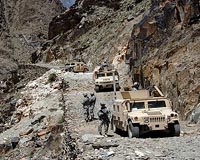| . |  |
. |
Dona Ana Range NM (SPX) Mar 18, 2010 Soldiers from 1st Combined Arms Battalion, 5th Brigade, 1st Armored Division, used the Small Unmanned Ground Vehicle and unmanned aerial systems in defensive and offensive training scenarios to improve awareness of hostile targets and increase reaction time and lethality of their fighting vehicles. "If you know it's coming from this direction then you can minimize your area of scan and be ready - so it gives us quicker reaction time," said 2nd Lt. Steven Northrop, a mechanized platoon leader with C Company, 1st CAB. The week-long exercise that took place the last week in February integrated the SUG-V and UAS into the unit's gunnery, said Capt. Andrew Hitchings, the assistant operations officer for 1st CAB. Hitchings said the scenarios were created to leverage the capabilities of the systems to detect targets earlier and make the crews more lethal on the gunnery range. "This is the first time that this has ever been done - using these future systems and live ammunition with tanks and Bradleys," said Hitchings. The unit used the SUG-V to identify whether personnel on the ground were friend or foe and for hasty surveillance to determine if an improvised explosive device was on the roadway, said Hitchings. Spc. Logan Rourke, a gunner from C Company, 1st CAB, said has worked with the SUG-V before and believes they are helpful. "The SUG-V can go where we don't want to," said Rourke. In the scenarios, the tanks and Bradleys operated in conjunction with the UAS overhead, to spot simulated enemy targets closing in from a distance and related the information to engage those targets. In respect to the use of the UAS; Hitchings said because a gunnery range does not necessarily reflect real life, but rather it tests the skills of the crews, the evaluation of UAS was more challenging. "Given a more developed range with some hills [and] some berms in which vehicles could move behind - then it would definitely be a valid way to test crews and their ability to acquire targets using these systems," said Hitchings.
Share This Article With Planet Earth
Related Links US Army The latest in Military Technology for the 21st century at SpaceWar.com
 LockMart Awarded Continues Production Of Symphony IED Jammer Systems
LockMart Awarded Continues Production Of Symphony IED Jammer SystemsSyracuse NY (SPX) Mar 17, 2010 The U.S. Navy awarded Lockheed Martin a sole source indefinite-delivery-indefinite-quantity contract for Symphony Radio Controlled Improvised Explosive Device (RC-IED) Defeat jammer systems. With an initial task order valued at $40.8 million, the contract runs through September 2014 and has a ceiling value of $940 million. The Symphony systems are U.S. Government-approved for sale through ... read more |
|
| The content herein, unless otherwise known to be public domain, are Copyright 1995-2010 - SpaceDaily. AFP and UPI Wire Stories are copyright Agence France-Presse and United Press International. ESA Portal Reports are copyright European Space Agency. All NASA sourced material is public domain. Additional copyrights may apply in whole or part to other bona fide parties. Advertising does not imply endorsement,agreement or approval of any opinions, statements or information provided by SpaceDaily on any Web page published or hosted by SpaceDaily. Privacy Statement |